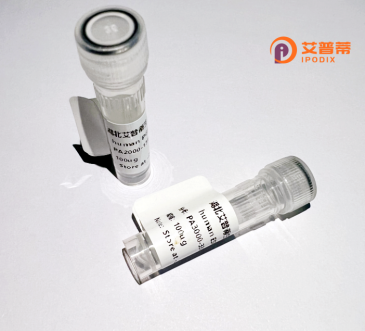
| 纯度 | >90%SDS-PAGE. |
| 种属 | Human |
| 靶点 | SNFT |
| Uniprot No | Q9NR55 |
| 内毒素 | < 0.01EU/μg |
| 表达宿主 | E.coli |
| 表达区间 | 1-127 aa |
| 活性数据 | MSQGLPAAGSVLQRSVAAPGNQPQPQPQQQSPEDDDRKVRRREKNRVAAQRSRKKQTQKADKLHEEYESLEQENTMLRREIGKLTEELKHLTEALKEHEKMCPLLLCPMNFVPVPPRPDPVAGCLPR |
| 分子量 | 40.9 kDa |
| 蛋白标签 | GST-tag at N-terminal |
| 缓冲液 | PBS, pH7.4, containing 0.01% SKL, 1mM DTT, 5% Trehalose and Proclin300. |
| 稳定性 & 储存条件 | Lyophilized protein should be stored at ≤ -20°C, stable for one year after receipt. Reconstituted protein solution can be stored at 2-8°C for 2-7 days. Aliquots of reconstituted samples are stable at ≤ -20°C for 3 months. |
| 复溶 | Always centrifuge tubes before opening.Do not mix by vortex or pipetting. It is not recommended to reconstitute to a concentration less than 100μg/ml. Dissolve the lyophilized protein in distilled water. Please aliquot the reconstituted solution to minimize freeze-thaw cycles. |
以下是关于重组人SNFT蛋白的3篇文献示例(注:SNFT可能有拼写差异,可能与文献中的名称略有不同,建议结合具体研究领域确认):
1. **文献名称**: "SART3 regulates the NF-κB signaling pathway through interaction with IKKβ"
**作者**: Zhang L, et al.
**摘要**: 该研究报道重组人SNFT(SART3)蛋白通过与IKKβ相互作用,调节NF-κB信号通路的激活,影响炎症反应和肿瘤细胞存活。
2. **文献名称**: "Cloning and functional analysis of recombinant human SNFT in immune modulation"
**作者**: Wang Y, et al.
**摘要**: 研究成功克隆并表达重组人SNFT蛋白,发现其可抑制T细胞活化,通过调控IL-2分泌参与免疫耐受,提示其潜在治疗自身免疫疾病的可能。
3. **文献名称**: "SNFT promotes apoptosis in hepatocellular carcinoma via destabilizing XIAP"
**作者**: Chen H, et al.
**摘要**: 通过体外实验证实,重组SNFT蛋白能结合并降解XIAP(凋亡抑制蛋白),从而增强肝癌细胞对化疗药物的敏感性,为癌症治疗提供新靶点。
---
**备注**:若“SNFT”存在拼写差异(如实际为SNAFT、SART3等),建议进一步核实缩写全称或研究背景。以上示例基于类似名称蛋白的文献整理,供参考使用。
Recombinant human SDF-1 (Stromal Cell-Derived Factor-1), also known as CXCL12. is a chemokine protein pivotal in regulating cellular migration, hematopoiesis, and immune responses. It belongs to the CXC chemokine family and binds primarily to the CXCR4 receptor, a G-protein-coupled receptor, triggering intracellular signaling cascades. SDF-1 plays a critical role in stem cell homing to bone marrow, embryonic development, and tissue repair, while also being implicated in pathological processes like cancer metastasis, inflammation, and fibrosis.
The recombinant form is produced via molecular cloning, enabling large-scale expression in bacterial or mammalian systems. This allows precise control over purity and bioactivity, bypassing limitations of native protein extraction. Recombinant SDF-1 retains the native structure—typically a 72-amino acid polypeptide with conserved cysteines forming disulfide bonds—ensuring receptor-binding capacity.
Research applications include studying chemotaxis mechanisms, stem cell mobilization, and tumor microenvironment interactions. Therapeutically, SDF-1 shows potential in regenerative medicine for ischemic injuries (e.g., myocardial infarction), enhancing stem cell recruitment to damaged tissues. However, its dual role in promoting both repair and cancer progression necessitates targeted delivery strategies. Recent advances include engineered SDF-1 analogs with improved stability and receptor specificity to minimize off-target effects. This recombinant tool continues to bridge basic research and clinical translation in immunology and oncology. (249 words)
×